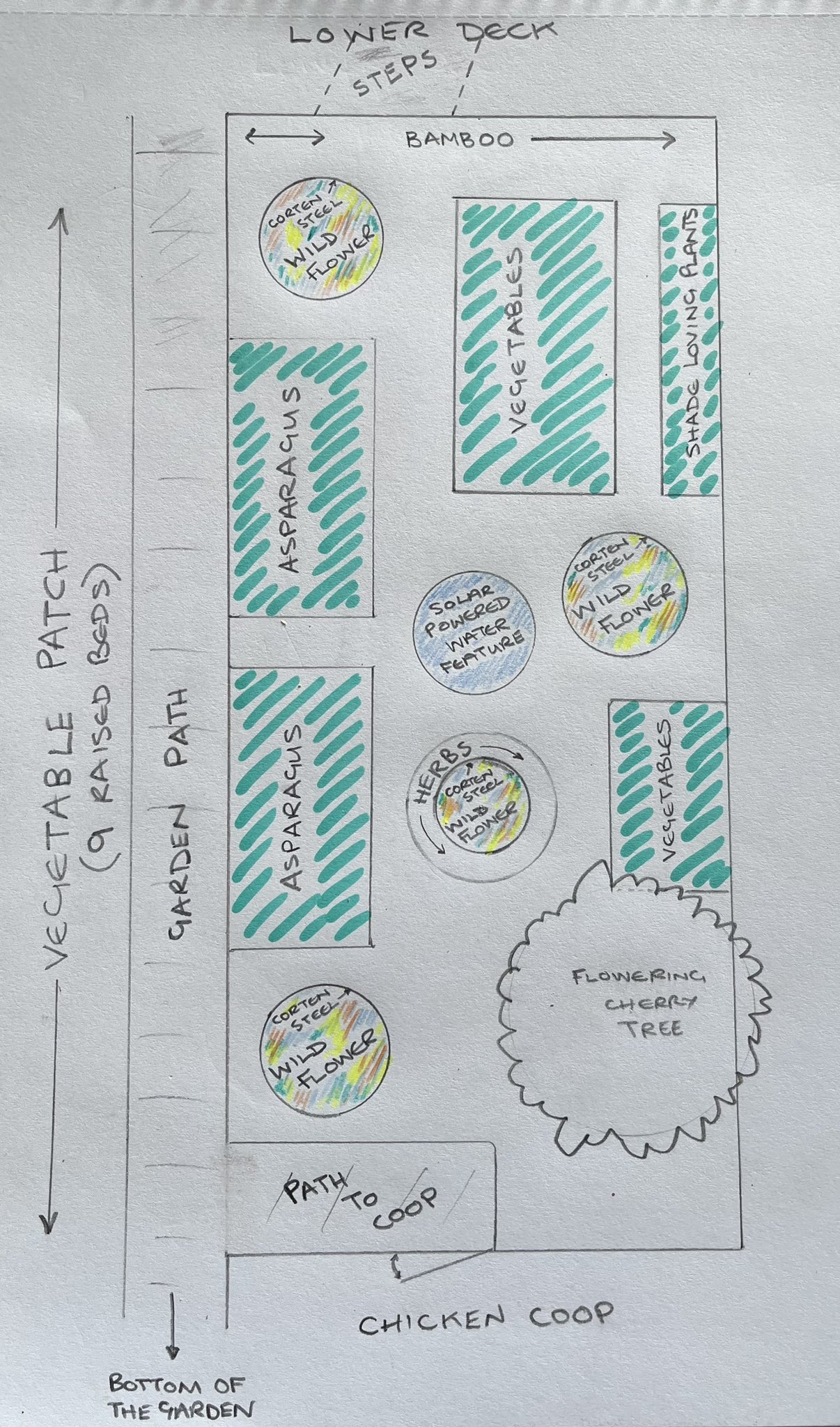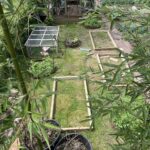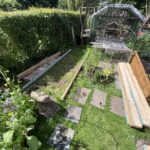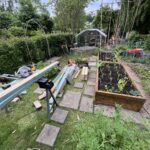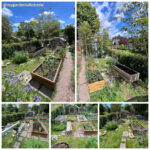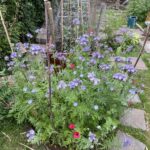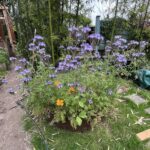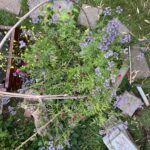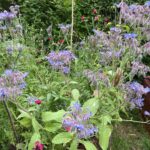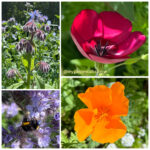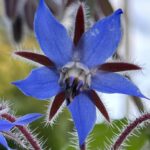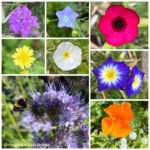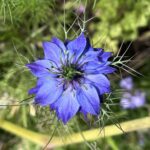100 centimetres ... or 100 acres!
... saying goodbye to the "lower lawn"
The focus of this piece is the repurposing of a section of the garden that had functioned as a play area for our two boys & the dogs. After many years of admirable service, of lolling & frolicking, ball play and somersaults, its days as a lawn had come to an end. The design intention in this part of the garden (let’s call it the “lower lawn” – a pretentious overture to what it once was), had three core elements. Four raised beds, a small Cor-ten steel herb bed, three larger circular Corten steel wildflower beds (100cm in diameter), and a water feature. The combination was intended to be simple, functional, and aesthetically pleasing.
Simple: … well, it is what it is. Four circles and four rectangles arranged on a piece of lawn.
Functional: the vegetable beds would be productive and easily accessed (especially important given the state of my failing knees – future proofing eh!). The Cor-ten wildflower circles would hopefully attract a wide variety of pollinators … and provide me with … something! I wasn’t sure what given that I’d never created a wildflower bed before. There was an early consideration of using the two 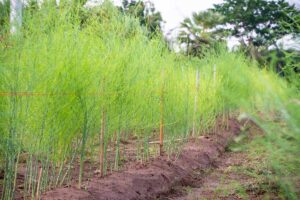 beds that border the path flowing down the garden with asparagus. In terms of space, in a small vegetable patch, this was a bit of a luxury I know, but there was also an aesthetic to my thinking in that once the asparagus had been picked, the fronds would form a pleasing, wispy border along the path. As it evolved, this idea was put on hold for the first year.
beds that border the path flowing down the garden with asparagus. In terms of space, in a small vegetable patch, this was a bit of a luxury I know, but there was also an aesthetic to my thinking in that once the asparagus had been picked, the fronds would form a pleasing, wispy border along the path. As it evolved, this idea was put on hold for the first year.
Aesthetically pleasing: I see no conflict between functionality and aesthetics. Things can work really well and look good. I like the exposed timbers of the raised beds, the juxtaposition of circle and oblong, the colour combination of browns, greens and an ever-changing floral panorama, and I also didn’t want the chickens to be looking out on some static, inert, landscape, like prisoners looking from one cell block to the next!
In relation to aesthetics, what is it about Corten steel? As I’m writing this, I’m looking out past the plane tree, across two hedges that border the middle garden, on to the red cedar stained top of the pergola on the screen garden – where all the screens are Corten steel. I’ve explored this in a little more depth in my exploration of the screen garden (see here)…
The build: So,to the build! The hard landscaping (i.e. The raised beds) were easy both in terms of construction and materials. I won’t bore you with the “how to build.” The materials were close to hand in that they were the reclaimed sections of the “whisky shed” that had been deconstructed in building the new workshop/studio.
The filling of the beds was more challenging. The size of the raised beds was such that I needed a lot of compost. If I were buying the soil, it would cost a fair bit but there was no rush. I don’t know about you, but I get quite a kick out of all thing’s “compost” (15 years ago, I could never have imagined saying such a thing!). One of the results is that I’ve got a “3-bin” system in the garden. Built from wood out of reclaimed garden projects and pallets, it works really well. Year 1 … fill Bin 1, year two, transfer Bin 1 to Bin 2 (& refill bin 1), Year 3 … transfer Bin 2 to Bin 3, and so on. By the end of Year 3, bin 3 is a well composted, dark, warm, friable mixture of nutritious garden glory. So I used what compost I had, enough to fill three of the four new beds.
Reflections on the first year
This project has been one of the most pleasantly surprising events in my gardening life to date. Who would have thought that a relatively small, 100cm circle of steel, could contain so much! I’ve thought about how to frame the following reflections and concluded that they might work if I write about what I feel I may have contributed to the garden, and what the garden has given back to me.
A clearer understanding of the reciprocity of gardening.
Gardening is, in essence, a reciprocal process. It is an act of both giving and receiving. It’s sometimes too easy to lapse into “take and control” mode when it comes to gardening, to express a planting proforma that speaks exclusively to what you want and not necessarily to what nature might want or need. Creating something that, in theory, will have balance, a life of its own and be of benefit not just to the onlooker but to the surrounding flora and fauna is, in essence, a way of giving back.
The wildflower planting didn’t instil in me a sense of smug satisfaction and self-righteousness, but nurtured more a feeling of connection to living processes, to the intricate, dynamic and natural process that is the garden.
New gardening knowledge:
Time … time …time … I found that the beds acted as some kind of horticultural vortex, drawing me closer, asking me to sit, to watch, to immerse myself in the ever changing display … and then to learn. There were some flowers that I recognised but the majority were a revelation to me. The first coloniser of the beds was the “Fiddleneck plant” (Phacelia tanacetifolia). I admit to being somewhat underwhelmed at the beginning given that, pre-bloom, each of the three beds was dominated by a thick covering of this wiry, grasping plant. I thought that it would be the one dominant feature, the big “I am” … but how wrong could I be. It produced a wonderful, bountiful, and unique flower that attracted so many insects. It was a signpost to what was to come!
Over the next few weeks, slowly emerging through the verdant orchestra of fiddle neck, a variety of plants reached out, sometimes transient, fleeting, sometimes with a little more staying power. Morning Glory, Speedwell, Borage, Poppy, Flax, Nigella, Scabious and more! I won’t go into much detail here as I’ll be elaborating on them in the “Flowers Gallery”(see here). In many ways the pictures speak for themselves. The one that struck me straight between the eyes was the delightful scarlet Flax. Mounted on lanceolate leaves, at times a dark heart, bleeding out in perfect symmetry, a ship’s propellor threatening to whirr into action, at times a burst of colour of such crystallised power that it dulled all in its immediate vicinity. A revelation for me!
An appreciation of the pollinator:
In providing a “compact and bijou” landing ground for a plethora of fauna, you are providing a stage on which the flyers and crawlers can dance, can perform, can entertain, can encore at will. Small copper, meadow brown, Burnet moth and Bumblebee dance around the blooms. Violet oil, ladybird, yellow flag and carder bee, soldier and swollen thigh, crawl, hover and fly, reaping the benefits of this rich and giving arena.
Space is not an issue:
It’s true that our garden is bigger than the average garden. Not huge, but bigger than most people’s growing space. The title of this piece, 100cms, is significant here. The rewards I took from the processes and outcomes of creating these beds aren’t limited to large growing spaces. Indeed, one of the beauties of this project is that it’s replicable in more confined spaces. I could see small wildflower/meadow beds on allotments, as part of a play area, part of a lawn, and even on a balcony. The fact that I’ve used Corten steel is irrelevant, any durable material would suffice. It potentially opens so many possibilities for so many to add something of value to their gardens/growing spaces.
.
Emotional connections:
Over the days, weeks and summer/autumn months, I recognised that the pausing by the beds provided an opportunity to practice (or maybe to rediscover), the life skill of “letting go”. I’ve mentioned this elsewhere on the site but it’s worth another plug. Those times when you can simply “be in the moment”, free from extraneous pressures, everyday demands, are to be savoured. I’m hesitant to use the word “mindfulness” because I think that it turns many people off these days. Perhaps it’s just me but my feeling is that it’s become tarnished with a label of middle-classness. I’ll stick with being in the moment for now.
However you want to view it, don’t underestimate removing or reducing the potency and power of the “should”. As a simple, reflective exercise, it can be quite useful to explore how much of what you do in the garden is a response to the word “should” (…I should be pruning, dead heading, mowing the lawn, weeding, “slugging” etc). Of course, there are always tasks that need to be done in the gardening year but if the majority of our gardening activities are served to us on a bed of “should”, it’s not difficult to see how our enjoyment of our gardens might slowly dwindle.
Once happy with that, the ability to relax and enjoy – the removal of a “should”, the circles came to represent, for brief moments of time … freedom, taking time to briefly look after myself … and that’s OK.
Conclusions
Just to reiterate what I wrote at the beginning of this section; the wildflower planting has been a revelation. I’m left with a cast iron commitment to continue a wildflower/meadow theme in this section of the garden and possibly/probably expanding it to other areas. I’m also looking forward to broadening my knowledge base in relation to wild/meadow flowers
The new raised beds have worked really well, and I’ll create more of these to replace the 9 flat beds on the other side of the path. One of next year’s tasks is to replace the deck boards on the top deck and much of the wood, whilst not good enough for the deck, will be fine for the new raised beds.
In terms of what I’ve “given” to the garden, my sense is that I’ve created a more ”dynamic” and interrelated space. Aesthetically, there is more beauty in the garden. Functionally, there are more productive spaces adding to the sustainability factor. In terms of what the garden has given to me … I would refer you to much of what I’ve written within this piece – connectedness, tranquillity, and another seed of anticipation that will nurture me through the cold of winter.

